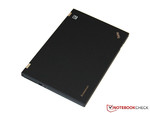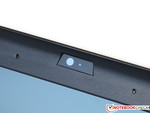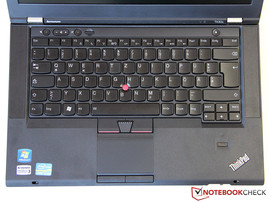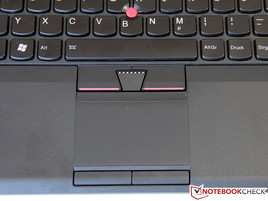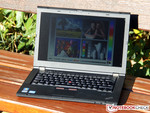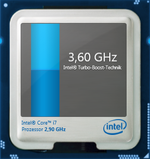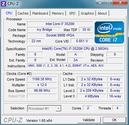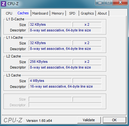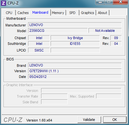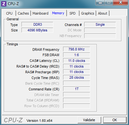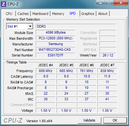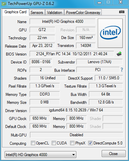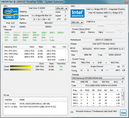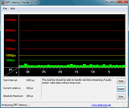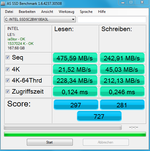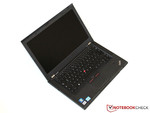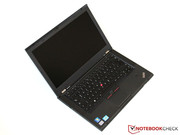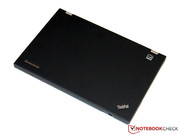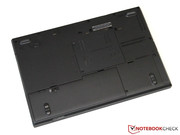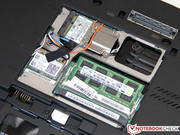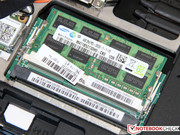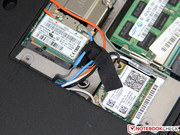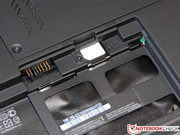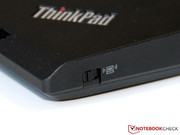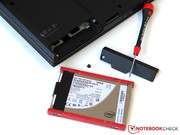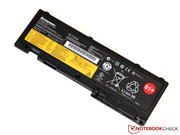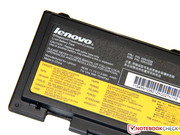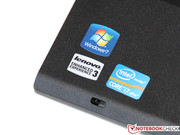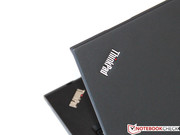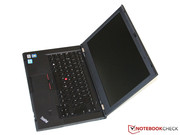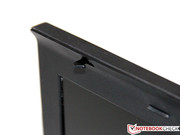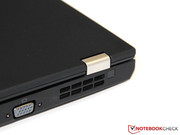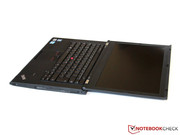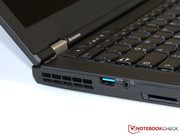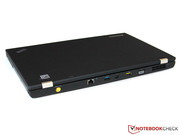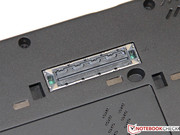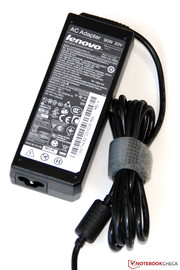Review Update Lenovo ThinkPad T430s Notebook

ThinkPad - this brand name is no longer only known by hardcore insiders and is now synonymous with business device excellence.
Regardless of this tradition, Lenovo's development has in no way slowed down: every year the model range undergoes a more or less comprehensive update, which should further improve on the already great qualities. A short time ago we took a look at the 2012 alternative of the 14-inch format, namely the slim ThinkPad T430s, and put it through a detailed test.
In addition to that article, we now want to take a second look at the over 1700 Euros (~$2200) top model (N1RGCGE) of the series, which we bought directly from a shop. Instead of a Core i5-3320M, there is a high end dual core Core i7-3520M at its disposal, the traditional hard drive is exchanged for a 180 GB SSD and a UMTS module has already been installed at the factory. Unfortunately, the Nvidia graphics card (NVS 5200M) available with other configurations is not available; meaning the integrated Intel GPU from the processor has to take on the work.
A comparison with the corresponding competition from HP and Dell - the EliteBook 8470p and the Latitude E6430s respectively - is not possible here and sadly that is our fault, since we haven't had the chance to get those models into our test lab for a review (tests being planned). Because of this, this test will be referenced to the predecessor T420s and also the big brother T430.
Case
Simple, straightforward, functional - the T430s fits seamlessly into the classic form and design language of the ThinkPad family. The now somewhat dusty appearance should not distract us from the inner qualities of the notebook: with a chassis made of carbon fiber reinforced plastic (CFRP) and magnesium, Lenovo relies on high quality and high tech materials. Despite the reduced thickness in comparison to the T430 (26 mm instead of 30 mm), the stability of the base unit and the display lid is very convincing. In conjunction with the clam shell frame and the solid metal hinges, the T430s is also well prepared for unfavorable environmental conditions.
Because we couldn't notice any manufacturing defects or other problems with our test model, we want to save on a new description with specific details - you can find all of these details in our first article for the ThinkPad T430s.
Connectivity
The predecessor model T420s had to make do with only one USB 3.0 port, but there are now two of them. Furthermore, there is also a USB 2.0 port with a 'Sleep and Charge' function, meaning the port still provides power when the laptop is turned off - so something like a smartphone can be charged over night.
Another innovation is seen with the connection of external displays: the integrated HD 4000 can run up to 3 monitors for the first time - theoretically it would be possible for the simultaneous operation of the notebook display as well as two external displays through VGA and Thunderbolt / Mini Display port (Core i5 version: Mini-Display port instead of Thunderbolt). We have asked Lenovo to confirm this assumption and we will update the article accordingly.
In the case that the provided interfaces do not suffice, the T430s can be expanded through the use of the docking station connector on the underside. The Mini Dock Plus Series 3 is available for about 150 Euros (~$194), which offers a number of other connections.
Communication
As with its sibling model, our test candidate comes with Intel's WLAN adapter Centrino Advanced-N 6205 in Mini PCIe form factor. With Multistream technology (2x2) up- and download gross transfer rates up to 300 MBit/s can be reached. In addition to the conventional 2.4 GHz, the device also supports the more exotic 5 GHz band (802.11a/b/g/n).
Next to WLAN and Bluetooth 4.0, the T430s-N1RGCGE also has an integrated WWAN module with the standard setup. LTE is unfortunately not supported by the Ericsson H5321gw, but the maximum possibility of 21.6 MBit/s (5.76 MBit/s Upload) in good UMTS networks with HSPA+-expansion leaves nothing to complain about. Useful: with a hardware switch attached to the side of the device, all wireless connections can be easily (de-)activated.
Security
The T430s has its own interesting security features, which are aimed at business customers. With a fingerprint scanner and a Kensington Lock the notebook provides protection against unauthorized access and theft respectively. Should the notebook be lost, the user can lock the ThinkPad remotely or destroy sensitive Data (Intel Anti Theft, Computrace). Further options are enabled through the already installed, although optionally deactivated, TPM chip, which, as an example, can be used for safe drive encryption with Windows Bitlocker (or similar programs).
Maintenance
The most important hardware components of the notebook can be reached with minimal effort and swapped out. Under the two screws of the maintenance panel are the two RAM slots (of which one is free), the WLAN module and also the WWAN module. Warning: the retrofitting of an mSATA SSD is only viable for models without mobile service! Another cover to the front left side of the notebook allows for the hard drive (2.5-inch, 7 mm) to be removed. For the Ultrabay slot, which is occupied by a DVD burner from the factory, there are also further expansions, such as an extra battery (3-cell, 31 Wh).
Warranty
Customers receive a 3 year manufacturer guarantee from Lenovo, where most others only give out a 1 or 2 year warranty for the quality of their products, this is a real highlight. If necessary, other service packs are available, extending the warranty time to 4 (about 120 Euros, ~$155) or 5 years (about 180 Euros, ~$232).
Input Devices
Keyboard, Touchpad and Trackpoint - this trio, called UltraNav by Lenovo, has been a hallmark of the ThinkPad series for years. Our detailed analysis can be found in previous tests of the T430s and also the T430. To put it simply: the high quality of all three input devices provides little room for criticism and are more than enough for a business device in this price range.
Display
In Germany the T430s is only offered with a matte WXGA++ Display (1600x900 pixels), which our US colleagues have already had the chance to take a close look at. With the 14-inch diagonal screen size, the display has a pixel density of a pleasing 131 DPI, which in our eyes makes sense as a compromise between font size and working area.
Lenovo advertises the display with a brightness of 250 cd/m² (WXGA Version: 200 cd/m²), which our Xrite i1 Pro 2 measuring device (previous tests: Gossen Mavo Monitor) confirmed as nearly exact with an average of 252 cd/m². What is peculiar here is the extremely uneven illumination - the bottom of the display emits almost 100 cd/m² brighter than the top. This is subjective, and can be a result of normal production variances. It's not that worrying and probably wouldn't even be noticed by most customers.
| |||||||||||||||||||||||||
Brightness Distribution: 69 %
Center on Battery: 280 cd/m²
Contrast: 200:1 (Black: 1.4 cd/m²)
38.49% AdobeRGB 1998 (Argyll 3D)
55.6% sRGB (Argyll 3D)
37.61% Display P3 (Argyll 3D)
The display has won some serious points from us here: thanks to the constant brightness (which also remains steady while on battery power) and a non reflective surface, the T430s can be used outside, even with direct sunlight - something that not many ultrabooks manage to achieve.
As we expected, our test model confirmed the poor viewing angles that we have already had to criticize in the past. The ThinkPad is clearly aimed at customers who normally use the notebook alone and from a straight on perspective. From even slight movement above or below the screen the result is clear image deterioration.
Finally, we take a look at the signal quality of the analog VGA output. While sharpness and image reproduction leaves us with a comparatively good impression even while at high resolutions, the slight ghosting (double images on the horizontal plane) is a less positive aspect.
Performance
Lenovo offers the T430s with two different Intel processors: the first is an entry level model Core i5-3320m, and the second variant is the faster Core i7-3520M. The latter is currently the fastest dual core processor on the market and comes from the Ivy Bridge generation. For better performance the Core i7 relies on not only Hyper Threading technology, but also the powerful Turbo Boost, which can raise the base clock speed of 2.9 GHz up to an impressive 3.6 GHz (2 cores 3.4 GHz). With a TDP of 35 watts the modern 22 nanometer process produced CPU fits perfectly into an office notebook of this size.
Our T430s-N1RGCGE has to pass on the optionally offered Nvidia NVS 5200M (including Optimus support), instead the processor integrated HD Graphics 4000 is responsible for the graphical output. Although Intel has made great progress in the graphics area in the last few years, this setup should result in clearly reduced 3D performance - as even the HD 4000 resides in the low end segment for graphics.
Considering the purchase price, the manufacturer has been somewhat restrained when it comes to the working memory, fitting the ThinkPad with only 4 GB of DDR3-1600. Because there is only one module, the RAM works in single channel mode, which reduces the graphical performance by several percentage points. A particular highlight is the 180 GB sized SSD, which we cover in more detail further below.
Processor
We begin with the processor. The Core i7-3520M is also installed in the sibling model T430 and the T530, and has already been through our test course multiple times. Can the slim T430s also take full advantage of the CPU power?
It can: even at constant utilization of all 4 threads (two core including SMT) in Cinebench R11.5 (64 bit), the Core i7 holds its maximum turbo clock speed of 3.4 GHz, which resulted in an excellent score of 3.37 points. With single threading an additional 200 MHz is added on, which raises the 3520M to striking distance of quad core models such as the Core i7-3720QM.
Speaking of quad core: with the Core i7-3612QM, as well as the 3632QM, Intel also offers a quad core in the 35 watt TDP class for the first time. Unfortunately, with these models, important features like VT-d or vPro are deactivated, which hinders application in a Lenovo business notebook. It's a shame - in accordance with the parallel software, this could raise the already excellent performance a further 60 to 70%.
Don't forget we also want the comparison between the i7-3520M and the i5-3320M: with less than 10% more power for the significantly more expensive Core i7, the customer should think very carefully about whether or not the smaller model would suffice.
Storage Devices
A fast SSD belongs without a doubt in a high end notebook, the corresponding advantages for every day performance are a lot stronger than those from the processor or other components. Lenovo hasn't just chosen any model here, but rather Intel's SSD 520, a particularly quick and reliable example of an SSD. Under the hood it is handled through the internally developed SandForce-SF-2281-Controllers, which are also used by other manufacturers such as OCZ and Corsair.
Depending on the program, the sequential transfer rates of 450 MB/s with reading and 250 MB/s with writing bring the SSD 520 on par with the popular Samsung SSD 830. Also in the other measurements, both drives are hard to separate: with small 4K data Intel's SSD can slightly break away, while the copy benchmark in AS SSD goes in favor of Samsung.
One thing is for certain: the SSD 520 is currently one of the best products on the market, and with a capacity of 180 GB (144 GB usable) should be sufficiently enough sized for most purposes.
System Performance
Thanks to the combination of the powerful processor and SSD, the ThinkPad possesses the tools necessary to excel in the system performance benchmarks of the PCMark series. It performs the tests with impressive results: 14,503 points in PCMark Vantage and 4519 points in PCMark 7 outdo all of our already tested office notebooks. The T430s tested by our US editors, which was equipped with a traditional hard drive, has to face defeat with scores of just under 50% less.
With normal office tasks our test model is left unchallenged and begging for a chance to use its available power reserves for more demanding software.
| PCMark Vantage Result | 14503 points | |
| PCMark 7 Score | 4519 points | |
Help | ||
Graphics Card
Depending on the CPU model, the frequency of the HD Graphics 4000 can clearly variate: in the case of the Core i7-3520M, the 16 executions are clocked at 650 MHz, furthermore a Turbo speed to a maximum of 1250 MHz is available.
Despite the sub-optimal single channel connection, we found a result of 646 points in 3DMark 11 (performance preset) - a typical value for the HD 4000, but middle class graphics solutions such as the GeForce GT 640M are already three times as fast. Moreover, when compared with AMD and Nvidia, there needs to be further improvement of drive quality, even if Intel has been able to catch up somewhat in the last few years. Multimedia tasks such as accelerated decoding and encoding (Quick Sync) of videos are easily handled by the card.
| 3DMark 06 Standard Score | 4504 points | |
| 3DMark Vantage P Result | 3184 points | |
| 3DMark 11 Performance | 646 points | |
Help | ||
CAD Performance
A really interesting comparison is the juxtaposition of the HD 4000 with the NVS accelerator from Nvidia in the CAD benchmark SPECviewperf 11. With the exception of the first two tests where the Intel Graphics solution does not at all (Catia) or only extremely slowly (Ensight) manage the benchmark, the results are surprisingly competitive. This is probably because Nvidia only offers special optimized professional drivers for the more expensive Quadro cards, and all other models - so not only for the GeForce series for consumers, but also the semi professional NVS cards - do not have this available.
| Lenovo ThinkPad T430s HD Graphics 4000, 3520M, Intel SSD 520 Series SSDSC2BW180A3L | Lenovo ThinkPad T430s NVS 5200M, 3320M, Hitachi Travelstar Z7K500 HTS725050A7E630 | Lenovo ThinkPad T430 NVS 5400M, 3520M, Hitachi Travelstar Z7K500 HTS725050A7E630 | |
|---|---|---|---|
| SPECviewperf 11 | 82% | 75% | |
| 1920x1080 Siemens NX (fps) | 1.4 | 2.52 80% | 2.32 66% |
| 1920x1080 Tcvis (fps) | 2.27 | 0.84 -63% | 0.88 -61% |
| 1920x1080 SolidWorks (fps) | 8.2 | 6.27 -24% | 7.86 -4% |
| 1920x1080 Pro/ENGINEER (fps) | 1.35 | 1.12 -17% | 1.15 -15% |
| 1920x1080 Maya (fps) | 10.4 | 7.53 -28% | 7.9 -24% |
| 1920x1080 Lightwave (fps) | 11.89 | 13.18 11% | 12.58 6% |
| 1920x1080 Ensight (fps) | 1.73 | 12.41 617% | 11.31 554% |
| 1920x1080 Catia (fps) | 4.61 | 4.53 |
Gaming Performance
A ThinkPad is designed for many different tasks, but gaming is not one of those things. Just like the questionable record of the theoretical tests has already shown, the HD Graphics 4000 falls far behind dedicated graphics cards and stay as just an entry level solution.
Anyway, if you are happy enough with minimum quality settings and a maximum resolution of 1024x768 pixels, games such as Anno 2070 or Diablo 3 are fluently playable with speeds of a good 40 fps. The fifth installment of the Elder Scrolls saga, Skyrim, stays at least playable with just under 30 fps.
Only the most demanding games like Battlefield 3 end in a less entertaining slide show - a hard to overcome limitation for a business notebook.
| low | med. | high | ultra | |
|---|---|---|---|---|
| Battlefield 3 (2011) | 15.7 | 12.2 | ||
| The Elder Scrolls V: Skyrim (2011) | 27.6 | 14 | ||
| Anno 2070 (2011) | 42.8 | 21.9 | 13.9 | |
| Diablo III (2012) | 45.9 | 26.5 | 21.4 |
Emissions
Noise Emissions
In comparison to our last test, the cooling system is somewhat more sensible and acts completely passive only when absolutely idle. Simple operations like surfing the internet or video playback raise the fan in levels up to a good noise volume of 35 dB(A). With the subjectively pleasing frequency characteristics, the T430s stays quite tolerable, even with longer use.
In 3DMark 06 the ThinkPad is more noticeable with a maximum noise of 37.2 dB(A). While under a full load, where we could measure a volume of 40.6 dB(A), the fan is not the biggest noise culprit of the notebook: the real blame rests on the optical drive, which blasts out a noise level of 45.9 dB(A) with DVD playback - film fans won't be getting their money's worth.
Temperature
With normal every day use there is no detectable significant heating of the case - sophisticated energy saving features of the processor ensure that the energy consumption and therefore heat dissipation is kept to a minimum while in idle mode. Therefore, the top and bottom sides both have temperatures resting around 30 °C, which allows for use on your lap without problems.
This is also true in principle while under heavy loads. Only around the fan outlet does the thermometer reach a value of between 40 to 45 °C, but aside from that, the ThinkPad is not excessively heated. Thanks to the rather cool palm rests, the user is not at all disturbed while working.
The only real heat source of the notebook is the Core i7-3520M, which after our hour long stress test of Prime95 and FurMark reached a temperature of just under 90 °C. Both the processor and the integrated graphics card stayed at their respective clock speeds of 3400 and 1250 MHz, which means a sufficient level of cooling. Customers of the ThinkPad don't have to waste any time worrying about throttling issues.
(±) The maximum temperature on the upper side is 40.2 °C / 104 F, compared to the average of 34.3 °C / 94 F, ranging from 21.2 to 62.5 °C for the class Office.
(-) The bottom heats up to a maximum of 45.8 °C / 114 F, compared to the average of 36.8 °C / 98 F
(+) In idle usage, the average temperature for the upper side is 30.1 °C / 86 F, compared to the device average of 29.5 °C / 85 F.
(+) The palmrests and touchpad are reaching skin temperature as a maximum (32.3 °C / 90.1 F) and are therefore not hot.
(-) The average temperature of the palmrest area of similar devices was 27.6 °C / 81.7 F (-4.7 °C / -8.4 F).
Speakers
As for the speakers, we have already covered them in our previous test so we will just refer to that. In short: for office use the small stereo speakers are adequate, for music or films the connection of an external sound system is recommended. This is possible through not only the audio jack (3.5 mm) but also through Thunderbolt (adapter to HDMI available from retailers).
Battery Life
Energy Consumption
With 7.5 to 12.1 watts the energy consumption in idle mode is not very surprising. Similar devices from other manufacturers can be a little bit more economical (Dell Latitude E6330), or likewise there are models with somewhat higher power needs (HP EliteBook 8570p with dedicated graphics).
In relation to the maximum power usage of 57.1 watts in the stress test, Lenovo has made the power adapter overly sized at 90 watts. Under realistic conditions that may happen, such as in a 3D game, the energy usage is even smaller - in 3DMark 06 we could measure an average value of just 43.1 watts. Whoever opts for the model variant with an Nvidia graphics card should expect an extra 10 watts.
| Off / Standby | |
| Idle | |
| Load |
|
Key:
min: | |
Battery Life
While the ThinkPad T430s can score points over the T430 when it comes to compact dimensions, it comes at the cost of part of the battery capacity. Instead of 57 or even 94 Wh the 6-cell battery of the T430s contains only 44 Wh; an extension of 31 Wh through the Ultrabay slot is only possible with the removal of the optical drive and is therefore not available for this test.
Despite these handicaps, our candidate is still very impressive in this area and confirms a time of over 7 hours in the Battery Eater Readers Test (energy saving mode, minimum brightness, wireless connections deactivated), which is almost at the manufacturer's claim (Lenovo: up to 7.6 hours). This test isn't fully relevant to practical use due to its minimal use of hardware power.
What is more relevant is our WLAN test (energy saving mode, 150 cd/m²), which simulates typical use of surfing the internet and playing HD videos. Amazingly, with a time of 4 hours and 37 minutes, this model outdoes the previous version by over 50% - wherein reason for these measurements may rest somewhat on Optimus, the automatic switching between two graphics cards.
While being burdened with the Battery Eater Classic Test (high performance, maximum brightness, wireless modules on) the notebook runs for as long as 1 hour and 12 minutes before running out of steam. In this case you should probably bring the power adapter along, which can recharge the battery within a good 2 hours. The full performance of the processor and graphics card remains fully available and unrestrained without the power adapter.
Verdict
Other features, same verdict: we can repeat the same conclusion in a similar form from our first test. The ThinkPad T430s is an absolutely solid evolution from the predecessor and an interesting alternative to the T430. As for the quality of the case and input devices, there is very little to criticize, which would have surprised us very much if there was, considering the track record in question.
In terms of performance, it is less the costly i7 processor but rather the SSD which makes the real difference. Even a fast hard drive with 7200 rpm can't get anywhere near the working speed of flash memory, which reduces the start up time of Windows and applications to a fraction of what it would be. All of these factors turn the compact T430s into a complete work device - and when necessary, traveling with UMTS.
What remains is the wish for a better display and a bit of fine tuning on the fan control or the loud DVD optical drive. Overall, you can't go wrong with the purchase of a ThinkPad T430s - but Lenovo seems to know this fact too, and so sets a rather self confident price of over 1700 Euros (~$2200).




